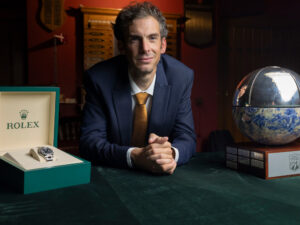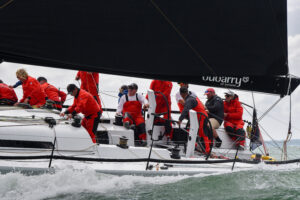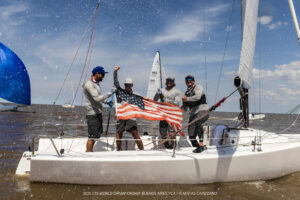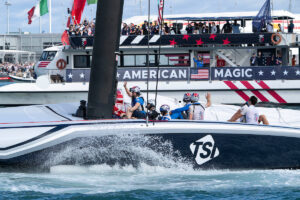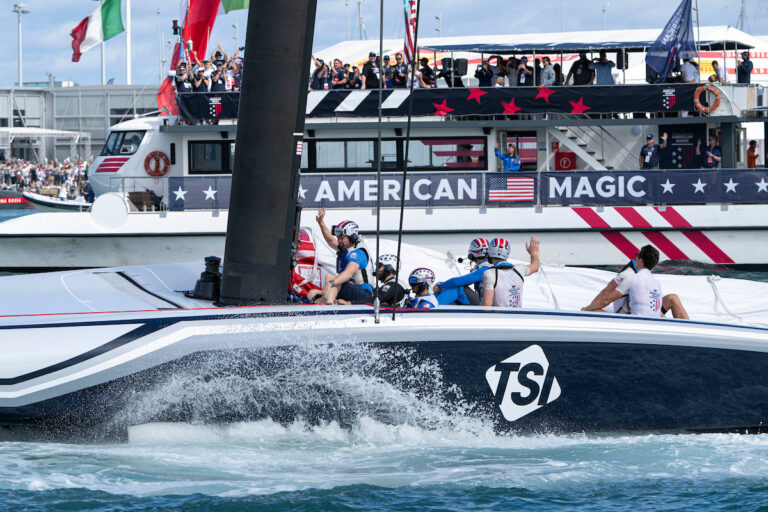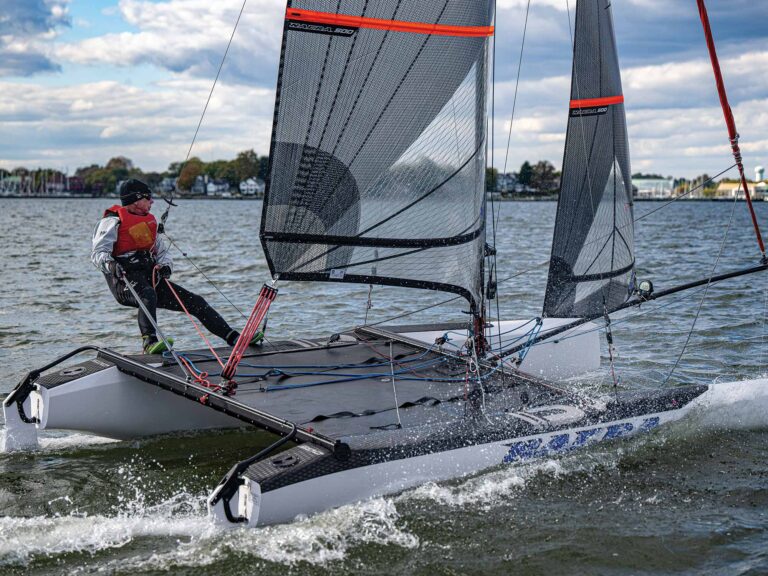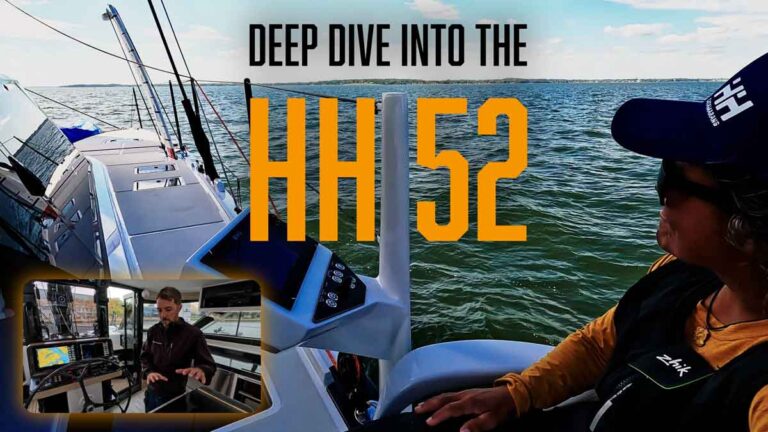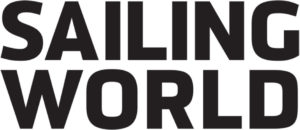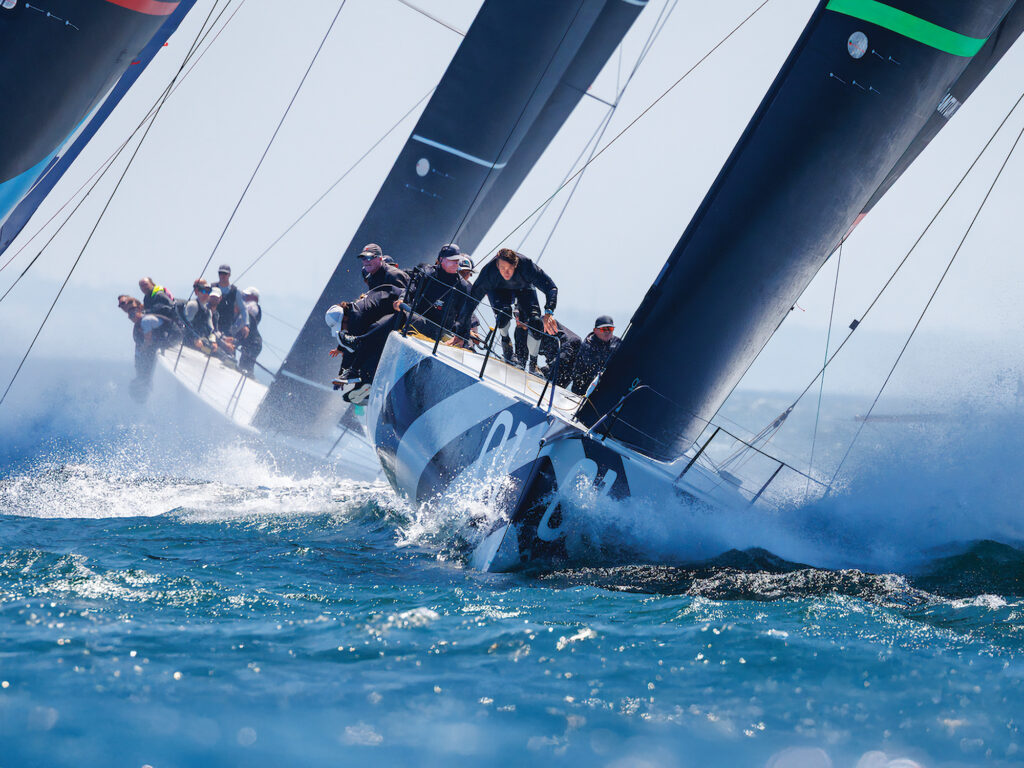
in the cutthroat world of Rolex TP52 World Championship sailing, where every point is hard earned and every mistake amplified, American Magic Quantum Racing clinched its eighth world title by the narrowest of margins. The elite 52 circuit demands a meticulous and disciplined approach, and for Terry Hutchinson, the team’s longtime skipper, success came through both human capital and a continuous evolution of the team’s boat and sails. On the waters off Cascais, there was a measurable but delicate balance of aggression and control that reflects the team’s ongoing transition to a younger, dynamic squad. There’s a “meat and potatoes” philosophy that underpins their success, even when the “red mist” descends. The boss shares his thoughts.
How do you approach this series every year to make sure you have the complete package?
To succeed, the first area we start is with the team, and specifically with the people, because the people are our number one asset. So, when we consider success on the racecourse, we have to look at the whole program. We set a disciplined strategy based around our people and what’s executable. It’s one thing to say, “we want to win this regatta,” but it’s more important to ask how we’re going to win the regatta. Tell me what’s going to separate our team from the others, and what’s going to help us win this regatta. So, as a team, we’re always thinking about the people, the boat, the sails and the equipment.
How far out of a world championship of this caliber does that need to happen?
At the end of the 2024 season, Cascais (Portugal) was announced as the venue for the world championship. Straight away, we knew it was going to be a reasonably windy venue. And inside the 52 class rule we have variations of sails that we can use or not. This was the first world championship that I’ve raced with a J3-plus, which is a sail that’s in between a J4 and a heavy. That was a difference maker, but it was something that we identified that we needed to have, at least in our sail program, have the option to put a button on it, if we wanted it.
So, there’s one area of development. There was also the A2-plus, which is stronger than the A2, but not as heavy as the A4. The structure inside that sail is slightly different, and the sail was pretty good down-range in 17 knots of wind, but very good in 23 knots without the risk of breaking. So that was another sail evolution that takes time.
Those are a couple examples of the sail development side of things that we considered to make sure that we gave ourselves the best chance at this event. It’s about reliability in the racing and reliability in the team. We’re a small team, so we’re sailing with an extra person on board, which is great. It makes the weigh-ins really hard, but that extra set of hands when it’s really windy is pure performance.
How essential was it to have that extra person?
By the time the regatta starts, all the teams would be overweight, but we’re carrying an extra person on board so we’re providing a little bit more hiking stability. And so, in a windy venue, and on these boats, you hike harder downwind than you do upwind, because there’s just so much to gain in performance. Where you see it on our boat going around the racetrack is everybody giving 110 percent in the hiking, so the performance there is awesome. It’s a measurable gain.
Teams push their boats and themselves so hard at these events, especially in the big breeze you had. How do you balance that part of it knowing there’s no room to hold back?
We had very good boathandling, and the reliability of our equipment and our boat comes out of that. We broke a lot of stuff, but we got exactly what we deserved by being too aggressive at times.
Is there one example that best demonstrates this?
One example is when we got into a tussle with the French at a top mark. We came around the mark, and the call was to do an “Indian,” which is basically a hoist and a jibe. The whole maneuver happens simultaneously. But we were on a J4 and it was 26 knots of breeze, and it was too windy, and I had a little bit too much red mist from the situation that we had just been in. I wasn’t thinking clearly and we went for the maneuver with some of the team members out of position. I’m responsible for taking up the new runner, and the new runner got trapped on the leeward side of the boom. The spinnaker went up inside the jib, and the turn was a little bit too fast, so the spinnaker ended up in the foretriangle. From there it snowballed.
This Quantum Racing team has been around for a long time and there’s a transition now to a younger squad working alongside mentors. What’s involved with that?
Starting on the bow, we now have Norm Berg, who’s the mid-bowman, and then Ian Liberty trims downwind. Victor Diaz de Leon is a strategist, Harry Melges (IV) is the helmsman, Sarah Stone is the navigator, and Luke Muller is the aft grinder. Individually, they’re all great sailors, so part of the learning process is getting us all to learn how to race together, how we communicate together and then instilling a certain level of discipline to know that at certain times we just don’t have to go for the kill. It’s consistency that’s going to win the regatta, it’s our reliability and how we interact with each other. I’ve nicknamed it “on board meat and potatoes,” because meat and potatoes aren’t fancy, but they’re always good.
That, however, requires a certain level of consideration that we’re fast and that we have optimum performance all the time. It’s always taken into consideration that our boathandling, and the things that impact the boat’s performance, are going to be the consistency of the team. Within that, there is a level of accountability. That gets discussed and it gets developed and becomes part of the team’s culture and who we are.
The new sailors may come with new ideas and approaches; how does those make their way into years of refinement and old habits?
We do have this balance of those with experience and those that have been developing their skill sets in smaller boats and coming onto something bigger. One good example is with Ian [Liberty]; after the first day of the regatta, because of his suggestions, we made an adjustment to our downwind technique, and we went from being just OK to easily being the fastest boat on the racecourse.
What was the improvement there?
We were sailing in a side swell, so on starboard, the swell was on the beam, and on port it was on the transom. So, on port jibe, you could do a normal surf. But on starboard, the technique change was a big ease on the kite and a big grind on the main—almost grinding the main to center line. So, the sail trim was very asymmetric, and we get these big downs on the waves. And as soon as the boat starts to decelerate, the kite gets trimmed on and the main gets eased out to a normal position as the apparent wind is going forward. It changed the performance of the boat in such a positive way, because we weren’t just sticking our bow in the waves. The boat was breaking free, but it was doing it in a down way, not in a bow up way.
You use the term “process” a lot, what does that mean within this world-caliber team?
The process is driven around the performance and our accountability on board. We’re disciplined when we leave the dock. We’re disciplined when we show up. It’s a commitment to seven points or less on the day, and to understanding that we don’t win the regatta on the first three days. You win it on the last two days, but you can’t take yourself out of it on the first three days.
We try really hard to share that level of responsibility on the boat. And I think that it’s something that is critical to the success everybody’s accountable for their areas, and at the same time, how you blend that together is probably where a lot of performance can come from, and then it’s just being tactically disciplined.
Everything about the 52 Series is sophisticated, especially onboard the boats where, in your case there’s yourself, a tactician, and a strategist in the afterguard, providing input all the time. How much latitude is left for the helmsman to follow his instincts in the moment?
We’re pretty diligent about not chirping too much. Let’s take the start for example. I help with getting them into the spot, and then the final time and distance—the last 60 seconds are on them. It’s never one person; there’s the bowman, there’s Harry and I, and then there’s Sarah giving the time to kill. So, Harry is managing the platform. I’m giving them feedback, reassuring his instincts, and really backing them up so he can be highly confident in what he’s doing.
The one race where we were OCS, the hard part was the computer and the Vakaros both had us behind the line by a reasonably large amount. All of our electronic inputs were saying we were racing, so we called Greg (Gendell) off the bow. Doing that, we lost our third point of certainty, and we were over by a meter or so. It goes back to the process, and there we slipped a little bit on our process. These are little things that even at the level that we’re after, we still make some of these mistakes.
How difficult is it these days, tactically, when no one is giving an inch?
The tactical side and the fleet management side of it is understanding where the boat can make gains, understanding the performance of the boat and your target boat speeds well enough. It’s understanding whether the posted target is the correct number to sail in that moment, or do you need to sail one-tenth under or over given each position of where you’re at. I can’t speak for what the other tacticians do, but I am very boatspeed focused in the moment, and continually updating the mode that we should be sailing. We won’t go more than 30 seconds without an update happening, because that’s how much we’re watching things evolve on the course. Regardless of whatever boat you’re racing, it’s important to have an intimate knowledge of the boat’s performance in traffic, versus a clean lane versus, boatspeed numbers and a range.
And what about fleet management?
I did two J/70 regattas this winter with 50- or 60-boat fleets. Getting clear and winning the first cross of a group of 20 boats versus being stuck in fifteenth is a massive difference. When you’re in fifteenth around the top mark your next opportunity to gain separation is downwind and picking a good spot to allow the boat to sail its mode, because traffic slows everybody down. It’s the same thing in the 52. At the Worlds we had 11 boats, so the hardest spot to be in was fifth, because it’s so easy to be in seventh if you screw up one thing. So, positioning wise, at any given time, we race with the mindset that people are going to make us suffer by tacking on us, so whatever we’re expecting, we have to pay it back to keep the distance the same.

